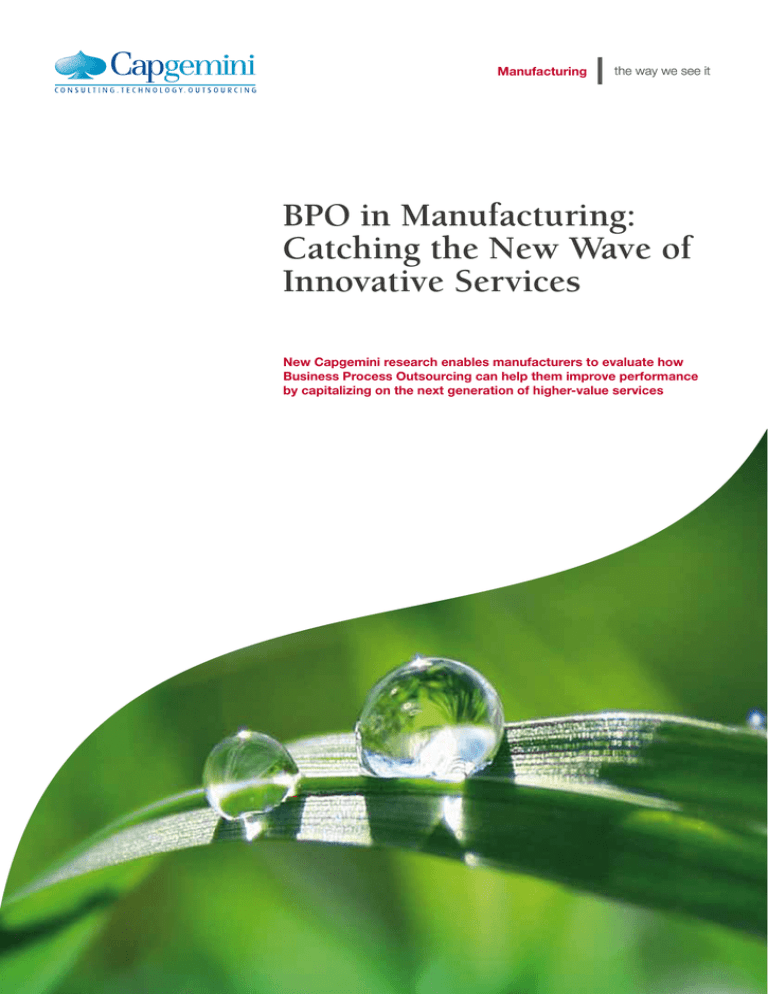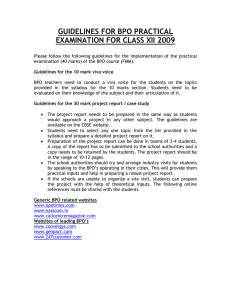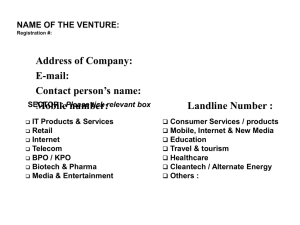
Manufacturing
the way we see it
BPO in Manufacturing:
Catching the New Wave of
Innovative Services
New Capgemini research enables manufacturers to evaluate how
Business Process Outsourcing can help them improve performance
by capitalizing on the next generation of higher-value services
Research Methodology: The Networked Value Circle Model
Research for the “BPO in Manufacturing” study was conducted by Capgemini Consulting’s
Manufacturing Lab in Mumbai, India.
The study analyzed the demand and supply side within the manufacturing industry through
the lens of the Networked Value Circle.* The old orthodoxy of a simple value chain in which
manufacturing firms take new materials, transform them into products and feed them into a
distribution system has gone. Manufacturers engage with their customers and distributors in
the very process of innovating and developing new products, and are closely concerned not
so much with pushing out good products, but with delivering value outcomes to customers
who embrace not only product features, but the whole experience of use throughout a
product’s lifetime.
This leads us to the transformation of a value chain, with inputs at one end and outputs
at another, to a value circle involving a continuous and developmental process of value
creation. Evaluation using the value circle enables us to:
•Identify and analyze the growth areas within the BPO market in the manufacturing
industry.
•Identify the various business functions within a company that have potential to be
outsourced.
•Identify the key focus areas that could be outsourced within a function.
The Networked Value Circle Model
INNOVATION PARTNERS
AND NETWORKS
SUPPLY CHAIN PARTNERS
AND NETWORKS
MANUFACTURING PARTNERS
AND NETWORKS
*“The Global Networked Value Circle: A New Model for Best-in-Class Manufacturing,” Capgemini and University of Edinburgh Business School
Manufacturing
As the global economy begins to show
signs of improvement, manufacturing
companies are shifting their focus to
growth while still keeping a close eye
on costs. No longer are organizations
just looking for low-cost transaction
processing or sourcing; they also want
solutions that can deliver business
outcomes and effectively support
them in addressing their challenges.
Increasingly companies are turning to
Business Process Outsourcing (BPO)
to help them achieve both goals,
through labor arbitrage and economies
of scale, together with optimized
common processes and improved
service levels.
Manufacturers historically have
outsourced non-core processes such
as human resources and finance,
and in recent years have extended
their outsourcing activities to areas
like procurement and supply chain.
Many companies are now beginning
to further expand their outsourcing to
higher-value services such as product
design and innovation; marketing,
sales and service management; and
even social media.
To better understand emerging trends
in BPO in the manufacturing industry
and to identify areas with new growth
potential, Capgemini conducted
research looking at the practices
of leading companies operating in
segments such as aerospace and
defense, automotive, high tech and
industrial products. The research
is designed to help manufacturing
organizations identify functions to
evaluate in their own operations where
BPO can assist in optimizing their
bottom line and improving the top
line.
the way we see it
Steady Growth Expected for
BPO Market
The global BPO market is expected to
grow at an average of 6.5% CAAGR
until 2015.1 This is driven both by the
continued growth of the traditionally
outsourced areas of finance and
accounting, human resources and
customer service functions, and the
rapid expansion of new scope areas
such as supply chain management,
product design and innovation, and
marketing support. To get a more
detailed view of what this growth
will look like, our research evaluated
current and emerging BPO trends
within the manufacturing industry
using our “Networked Value Circle”
model (see previous page).
The research focused on five
functional areas: finance and
accounting (F&A), product design and
innovation, supply chain management
(SCM), marketing, sales and service
(MSS), and human resources (HR).
The study highlighted the following:
•In F&A new offerings like decision
support and financial planning and
analysis will fuel growth in the
coming years.
•The product design and innovation
market, while small, is expected to
post gains in the next few years.
•In SCM, 4PL logistics integration
will be an area of significant
growth.
•In MSS, both customer service
management and technical
publications will remain highgrowth areas.
•In HR, growth is expected to
be slow with a large number of
specialized players in a relatively
mature market.
1 NelsonHall: “Global BPO Market Forecast: 2011-2015,” October 2011
BPO in Manufacturing: Catching the New Wave of Innovative Services
3
business performance analysis
and reporting, new business and
pricing analysis, and audit and risk
management. Areas less likely to be
candidates for BPO include external
reporting, tax planning and treasury
management.
Further, our research also identified
higher-than-average growth of the
BPO market in the Asia Pacific and
Latin America regions across all areas.
Following is a deeper dive into the
research findings for each of the five
functional areas.
Although transactional F&A
outsourcing represents a mature
market, new, non-core activities
like decision support and financial
planning and analysis are expected
to fuel gains in the new few years,
helping to contribute to a projected
growth rate of at least 10%. Leading
BPO vendors are expected to develop
capabilities that will enable them to
provide end-to-end offerings within
the F&A BPO landscape.
Finance & Accounting: New
Services Will Fuel Gains
Most leading manufacturers have
long outsourced their transactional
F&A activities like accounts payable,
travel and entertainment, billing
and invoicing, order management
and collections, general ledger and
fixed assets. Some organizations are
now moving to outsource higherend processes such as cost analysis,
Est Market Size in $ Million
F&A BPO Forecast by Region: 2011-2015
$1,749
$2,470
$114
(10.3%)
$21,006
(6.4%)
(10.3%)
$25,549
(3.6%)
R 5.0%
CAAG
Global
2011
North
America
Latin
America
EMEA
( ) - CAAGR
Source: NelsonHall: “Global BPO Market Forecast: 2011-2015,” October 2011
4
$209
Asia
Pacific
Global
2015
Manufacturing
Product Design & Innovation:
Poised to Grow in Coming Years
The BPO market for product design
and innovation services is relatively
small, but is projected to grow
by almost 30% in the next four
years.2 Some leading manufacturing
companies are beginning to offshore
their less critical R&D tasks through a
shared-services model in developing
countries. Activities increasingly
being outsourced include technical
publications, drafting and modeling,
testing, systems design and prototype
design.
Organizations are offshoring product
design and innovation activities not
just for the cost benefits, but also
to achieve flexible resource capacity
(especially in industries with cyclical
engineering workloads and short
product lifecycles), reduce time to
market, access to specialist tools,
and acceleration of development
for localized products for emerging
markets.
Engineering & R&D Services Global Offshoring Market
(US$ 000 million)
28%
40
Offshoring
15
CAGR
1.4
2009
Outsourcing
3.75
2013
Note: In offshoring, internal shared services are delivered from an offshore location for the benefits of labor arbitrage.
Outsourcing refers to delivery by a third party for the benefits of both labor arbitrage and access to skills and best practices.
Source: Capgemini Consulting Manufacturing Lab analysis
the way we see it
EMEA and the Americas represent
the biggest markets for product
design and innovation BPO within
the manufacturing sector, with high
tech and aerospace and defense the
most active segments. In the aerospace
segment, BPO activities focus mainly
on engineering services, while a large
number of high tech companies
outsource the majority of their
research and development work to
BPO vendors or specialized providers.
Some automotive manufacturers are
outsourcing activities such as design,
prototyping and CAD, while many
industrial product manufacturers
have set up captive or shared-service
centers to handle R&D activities.
Most BPO vendors are investing in
new capabilities like research and
product design to increase their
portfolio of services and move
higher up the R&D value chain.
For example, in the aerospace
segment, capabilities have evolved
from basic CAD/CAM, software
development and homologation, to
composite design, tolerance analysis
and digital prototype assembly.
In addition, capabilities are being
developed in high-complexity areas
of core/advanced R&D, including
biofuel-based engine development
(environmental compliance), crash
simulation and high-end design work
like aircraft engine design.
In the automotive segment, current
capabilities (mainly of medium
complexity) include middleware
and application development,
sub-assembly design, digital
manufacturing, and technical and
plant simulation. However, BPO
vendors are now investing in new
offerings to move up the value chain
to offer services around design
automation, integrated system design,
and hardware and chip design.
2 Capgemini Consulting Manufacturing Lab analysis
BPO in Manufacturing: Catching the New Wave of Innovative Services
5
Supply Chain Management:
Increasing Complexity Will Drive
Outsourcing Trend
The research focused on three key
areas within SCM:
•Order Management
•Procurement and Sourcing
Management
•Logistics Management
Order Management: The Order
Management BPO market is expected
to grow by approximately 10% over
the next few years as manufacturing
companies continue to outsource endto-end processes. Local provisioning
is expected to decrease significantly
over current levels as companies
adopt either shared-service centers
or outsourcing for their order
management services. Key growth will
come from end-to-end management
offerings to address different
degrees of complexity and customer
configuration among manufacturing
organizations.
Procurement and Sourcing
Management: For some time,
manufacturing companies have
outsourced their procure-to-pay cycle,
including activities like requisitioning,
purchase order management and
invoice processing. A growing trend
involves outsourcing the entire sourceto-pay cycle, taking into account
activities such as managing catalog
content, tracking and improving
supplier performance, supplier
e-procurement set-up, developing a
sourcing plan and conducting spend
analysis.
6
As the global economy continues
to revive, analysts expect the
procurement BPO market within
the manufacturing sector to grow at
a fast pace. The strongest gains are
anticipated in EMEA and Asia Pacific
and with niche activities like indirect
procurement.
The high tech segment will continue
to lead the outsourcing market within
the procurement function. In contrast,
the aerospace and defense segment
will continue to centralize sourcing
and procurement within a sharedservice center and be less likely to
outsource these functions.
On the vendor front, providers are
consolidating the sourcing BPO
market through acquisitions and
partnerships in order to offer end-toend services that include procurement
operations, operational sourcing and
strategic sourcing.
Logistics Management: The
global recession had slowed the
outsourcing of logistics operations
in the manufacturing industry but
it is steadily rising again, especially
in EMEA. As supply chains become
more complex they are increasingly
being outsourced to logistics service
providers, which are focusing on
developing capabilities around the
strategic logistics portion to manage
the entire logistics value chain.
the way we see it
Manufacturing
The logistics outsourcing industry
is expected to grow in the next few
years by at least 10% due to the
recognition of the supply chain as a
driver of enterprise-wide performance
improvements and greater competitive
advantage.
Much of the outsourcing activity
centers around fourth-party logistics
(4PL), independent coordination
of end-to-end logistics services for
maximum benefit. By adopting a
holistic approach 4PLs have been
able to integrate the competencies of
various logistics players, including
third-party logistics (3PL) providers,
leading-edge consulting firms and
technology providers. This has
enabled them to offer manufacturers
better pricing and a wider range of
services.
The automotive segment remains
a strong BPO market for logistics
services, while high tech has seen
significant growth in this area in the
past few years.
As the demand for sustainable
operations increases within the
manufacturing sector, BPO vendors
can help their clients maximize the
sustainability of their supply chain
through increased consolidation,
routing and mode selection. A
desire for cost reduction as well as a
concern about sustainability should
encourage logistics BPO providers to
move from air to ocean or from road
to intermodal and rail transportation
when choosing transportation modes
for their clients.
Most Frequently Outsourced Logistics Activities
User Percentages
Outsourced Logistics Service
All Regions
North
America
Europe
Asia
Pacific
Latin
America
International Transportation
78%
66%
91%
77%
84%
Domestic Transportation
71
65
77
74
69
Warehousing
62
65
61
65
63
Freight Forwarding
57
52
54
64
65
Customs Brokerage
48
49
43
56
45
Reverse Logistics (Defective, Repair, Return)
27
25
28
33
22
Cross-Docking
26
29
28
25
22
Product Labeling, Packaging, Assembly, Kitting
24
19
28
24
26
Transportation Planning and Management
23
24
27
21
16
Inventory Management
21
20
16
27
25
Freight Bill Auditing and Payment
17
35
12
11
8
Information Technology (IT) Services
15
15
14
13
16
Order Management and Fulfillment
14
19
10
15
14
Service Parts Logistics
14
10
14
19
10
Customer Service
11
9
7
14
16
Supply Chain Consultancy Services Provided by 3PLs
11
15
7
13
9
Fleet Management
10
8
9
14
9
LLP (Lead Logistics Provider)/4PL Services
9
7
10
13
4
Sustainability/Green Supply Chain-Related Services
4
3
3
6
4
Source: 2012 16th Annual Third-Party Logistics Study, Capgemini Consulting, Penn State University, Panalpina, Heidrick & Struggles, eyefortransport
BPO in Manufacturing: Catching the New Wave of Innovative Services
7
Marketing, Sales and Service:
Growing Demand for HigherValue Services
The BPO market for marketing, sales
and service is relatively mature in
areas such as publication services,
customer analytics, and contactcenter and channel management. In
particular, document management
processes like publication and
master data management have
been increasingly outsourced by
manufacturing companies enabling
them to concentrate on core processes.
Strong demand is anticipated for
services that combine cost reduction
with improved customer experience.
Customer service management
outsourcing is expected to increase as
companies look for additional ways
to improve customer interaction and
retention, or move into new markets
or customer segments. Customer
service management is also gaining
importance in economies such as
India and Brazil.
From a segment standpoint,
aerospace and defense companies are
primarily outsourcing publication
and information management
activities. Automotive OEMs are
mainly outsourcing document
management, customer care and
service management. And high tech
companies are outsourcing their
customer care and CRM activities.
However, opportunities exist to
expand BPO into higher-value areas
like business analytics, customer
relationship management (CRM) and
market intelligence. These new areas
will help drive steady growth for MSS
in the next few years.
Customer Management Services Market Forecast by Region: 2011-2015
Est Market Size in $ Million
$23,711
$8,731
(5.9%)
(9.3%)
$52,786
$26,542
$68,722
(10.1%)
(5.8%)
R 6.8%
CAAG
Global
2011
North
America
Latin
America
EMEA
( ) - CAAGR
Source: NelsonHall: “Global BPO Market Forecast: 2011-2015,” October 2011
8
$9,738
Asia
Pacific
Global
2015
To address the increasing demand for
higher-value services, BPO vendors
are expanding their expertise in
business and customer analytics and
other innovative services such as
product master data management,
customer interaction management and
interactive marketing. A number of
investments are being made by BPO
vendors, including:
•New service offerings in sales
support with the ability to impact
not only general and administrative
costs but also cost of goods sold.
A typical suite of services may
include lead qualification, customer
profiling, quoting, pricing, service
revenue assurance and channel
partner support.
•Acquisition of mid-size companies
that provide analytics and data
management services with expertise
in specific industries.
•Acquisition of companies that
develop web-based marketing
platforms to assist in creating
and hosting sales and marketing
solutions that enable businesses to
engage consumers earlier in their
decision-making process.
•Acquisition of companies that
provide business processes and
methodologies dedicated to the
after-sales operations of industrial
companies, an area of growing
importance.
Manufacturing
Human Resources: Mature
Market with Slower Growth
Transactional HR activities have
long been outsourced by many
manufacturing companies, and the
market is very mature with a number
of established global players. The
growth rate is expected to remain
steady, averaging only about 5% by
most estimates, with much of the
growth coming in the Asia Pacific
region.
HR BPO Market Forecast by Region: 2011-2015
Est Market Size in $ Million
$9,187
$53,015
$3,432
$590
(6.7%)
(8.3%)
$1,432
$67,656
(9.7%)
(5.7%)
R 6.3%
CAAG
Global
2011
North
America
Latin
America
EMEA
Asia
Pacific
Global
2015
() - CAAGR
Source: NelsonHall: “Global BPO Market Forecast:
2011-2015,” October 2011
Current HR services being widely
outsourced include employee record
keeping, benefits administration,
payroll and relocation services.
Additional employment services
such as training administration and
recruitment assessment are also
being outsourced extensively. Other
potential outsourcing candidates
include learning management, change
management, and compensation and
benefit analysis. Those less likely
to be outsourced are performance
management, labor relations, HR
policy and HR strategy.3
the way we see it
The HR BPO market is largely
dominated by vendors offering endto-end or multi-process HR solutions
and that should remain the case in
the coming years. Expected HR BPO
growth areas include professional
advisory services and corporate
governance services.
Social Media: A New Candidate
for BPO
Adoption of social media among
manufacturers is increasing as
companies begin to realize benefits
in areas such as product cocreation, marketing, and customer
communication and interaction.
Leveraging social media to generate
measurable benefits with activities
ranging from service management to
marketing of new products is used
by customer service departments
inside manufacturing organizations.
Adoption of social media by
manufacturers is expected to continue
to gain momentum as companies try
to connect with customers at various
stages of the product lifecycle.
As manufacturers expand their
activities in social media and social
marketing, some are beginning to look
to third parties to more effectively
manage this early-stage service. While
BPO services in social media are in the
nascent stage, growth is anticipated
in the coming years as manufacturers
look to outsource services such as
e-mail marketing, social campaign
management, social media marketing,
and web and social media analytics.
3 TPI, www.tpi.net
BPO in Manufacturing: Catching the New Wave of Innovative Services
9
Conclusion: Taking Advantage
of Higher-Value Services
For many years, manufacturers have
outsourced processes in order to
reduce operational costs and gain
access to skills and technology in a
more flexible operating model. Our
research makes it clear that new
opportunities exist to not only extend
the scope of outsourcing, but improve
performance and the top line by
outsourcing higher-value services. To
take advantage of these opportunities
we recommend that manufacturing
companies take the following actions:
Benchmark: Look to your traditional
and non-traditional peers to find out
what is being outsourced. Consider all
aspects of the enterprise.
10
Focus on outcomes: Consider as
an organization the specific business
outcomes you want to focus on,
then work with solution providers to
achieve these outcomes.
Accelerate: When looking at new
markets, business segments or
expansion, consider outsourcing
to gain competitive advantage and
accelerate business benefits.
Be brave: When outsourcing services,
maximize the end-to-end scope to
reduce the impact of hand-offs in
processes.
Multisource: One size does not fit
all, and while it is important to keep
the number of vendors low to reduce
governance costs and risk, specialist
providers in specific areas may offer
greater advantages.
BPO in Manufacturing: Catching the New Wave of Innovative Services
11
www.capgemini.com/manufacturing-bpo
For more information on our “BPO in
Manufacturing” research, please contact:
Greg Bateup
+44 7891 15 2422
greg.bateup@capgemini.com
Nick Gill
+44 7891 15 5699
nick.gill@capgemini.com
Derek Crates
+44 870 900 5008
derek.crates@capgemini.com
Capgemini’s “BPO in Manufacturing” research
was conducted by Capgemini Consulting’s
Manufacturing Lab, Mumbai, India, led by
Saurabh Kulkarni.
About Capgemini and the
Collaborative Business Experience™
With more than 115,000
people in 40 countries,
Capgemini is one of the world’s
foremost providers of consulting,
technology and outsourcing services.
The Group reported 2010 global
revenues of EUR 8.7 billion. Together
with its clients, Capgemini creates
and delivers business and technology
solutions that fit their needs and
drive the results they want. A
deeply multicultural organization,
The information contained in this document is proprietary. Copyright ©2011 Capgemini. All rights reserved.
Capgemini has developed its own
way of working, the Collaborative
Business ExperienceTM, and draws on
Rightshore®, its worldwide delivery
model.
Learn more about us at
www.capgemini.com.
Rightshore® is a trademark belonging to
Capgemini








